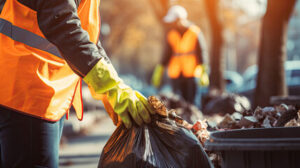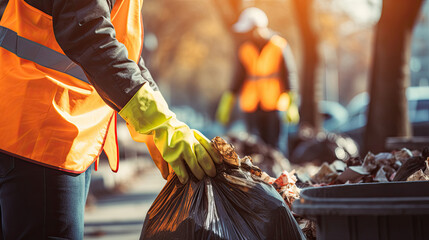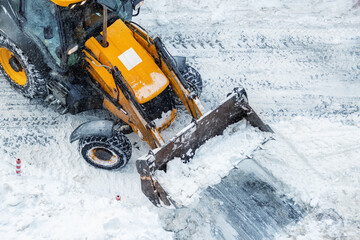Mandurah Rubbish Collection reduces the amount of junk in landfills by recycling and donating items. They also help people reclaim space in their homes and offices.
Most of the stuff that ends up in trash can be recycled, including paper materials, most metals, and e-waste. However, some junk removal services, especially bulky or hazardous items, will not take everything.

Recycling is a process of turning waste into new materials and products. It helps to reduce the amount of trash that is thrown away and can save natural resources. It also reduces greenhouse gas emissions from decomposition of garbage in landfills. In addition, it creates jobs and contributes to the local economy. Using junk collectors that offer recycling services can help people reduce the amount of trash they produce, as well as save on landfill fees.
Junk collection companies usually work with a team of other professionals, including drivers, loaders, and sorters. These individuals use specialized trucks and equipment to collect large and heavy items. Once the items are collected, they are transported to a recycling plant where they are separated into different categories for processing. The material is then sold to companies who turn it into new products. The recycled materials help to reduce the need for virgin resources, which can be costly and damaging to the environment.
Some materials are not recyclable, such as hazardous waste and food containers. Others have a limited shelf life before becoming too degraded to make into new materials. Paper can be recycled five to seven times before it becomes too soiled, while glass and metal can be recycled indefinitely. Some people are experimenting with a higher form of recycling known as upcycling. This involves reusing old products as something of greater value, such as shoes made from used tires or furniture from recycled wood.
While recycling is a great way to reduce the amount of trash we produce, it’s not the only answer. The best solution is to produce less waste in the first place, so that we don’t need to recycle as much. However, for the waste we do produce, it’s important to separate materials for curbside recycling. Metals, glass jars and bottles, rigid plastics (the number on the package doesn’t matter), and cartons should be placed together in a labeled bin with a secure lid or in a clear plastic bag. Bundled cardboard (flattened and tied with twine) should be set out next to bins or bags.
Donating junk items is a great way to help your community and declutter your home. It also helps prevent discarded items from ending up in landfills, which can pollute the environment. In addition, junk donations can be used to fund a variety of programs for individuals who need it the most. These programs include job training and employment placement services, providing food or clothing to those in need, and more. In many cases, donated items are resold and the profits go to a charitable organization. The profits from resale can help provide educational or career training, medical equipment and supplies, building community centers, and more.
When deciding whether or not an item is worth donating, first ask yourself if it has been in use by you or your family members for at least six months. If not, it is likely time to let it go. Also, consider what sort of memories the item has created for you and your family. For example, a family heirloom may be sentimental and difficult to part with, but if you don’t plan on passing it on to someone else, it is probably time to donate it.
Despite the fact that some people can pass off junk as treasure, most donation centers want only the best for their beneficiaries. This means that the items you give them must be in good working condition, free of stains and tears, and comply with safety standards. It costs charities money to collect and dispose of items that they can’t sell, so you should only give them what you would feel comfortable giving to your own children.
It’s also wise to consult the website of each donation center to see what types of items they are looking for at any given time. For instance, some charities are more interested in furniture than others. Others are looking for specific types of items, such as toys or sporting goods. Some organizations also have a mission component, such as the Market Street Mission in This charity helps individuals overcome poverty, addiction, and homelessness.
Repurposing is an excellent way to save money and the environment. Many things that can be reused include clothing, furniture and office supplies. The process of repurposing is different from recycling, which involves a chemical or mechanical change to an item. In contrast, repurposing changes the purpose of an already existing object without changing its shape or composition.
The repurposing trend has been popularized by a growing movement toward minimalism and green living. However, the idea of repurposing goes far beyond just being environmentally friendly. It is also a great way to make your home and workspaces look unique and appealing. The best part is that it’s easy and cheap! An old door can become a coffee table or a worn out dresser can be transformed into a love seat. The possibilities are endless!
Reusing and repurposing materials reduces waste and pollution, and limits the need for new natural resources. For example, a new consumer COTS surplus parabolic dish used for C band satellite TV reception can be repurposed as an amateur seismic node in a distributed seismograph network, or as a Wi-Fi repeater or microwave radio beacon. In addition, reusing old electronics and reusable packaging helps to reduce the need for waste disposal and landfill space.
Aside from being environmentally friendly, repurposing is also cost effective and can help you save on shipping costs. By using reusable packaging, you can save on the price of a box and reduce the number of trips needed to transport your items. You can also save on shipping fees by donating unwanted items to local charities.
Another advantage of repurposing is that it allows you to reach new audiences by presenting your content in different formats. This is especially helpful if you are targeting different audiences and keywords. This way, you can improve your content visibility and boost your search engine rankings.
Reusing is a great alternative to buying brand-new items. It saves on the energy involved in dismantling and remanufacturing and keeps us away from polluting landfills. It is a great way to promote sustainability and encourage people to avoid single-use products. For example, you can replace plastic straws with metal ones or use reusable food wrap. Similarly, you can also swap out disposable cleaning wipes with cloth ones. These small swaps can make a big difference in the world we live in!
Styrofoam is a common material used for packaging and insulation, but it poses significant environmental threats. Its non-biodegradable composition means that it takes hundreds of years to break down in the environment, and its disposal in regular trash contributes to landfill problems. In addition, it is a major cause of ocean pollution, where it can fragment into small pieces and be consumed by marine animals. Fortunately, there are ways to get rid of Styrofoam and protect the environment.
Recycling is one of the best ways to get rid of styrofoam, and it can be done in many different ways. For example, you can use acetone to break down the polystyrene foam and make it soluble. Alternatively, you can also use paint thinners to break down the material. These liquids will dissolve the carbon-hydrogen bonds in Styrofoam, which makes it easier to break down and recycle.
Most municipalities do not recycle styrofoam, so you’ll need to find an alternative method of getting rid of it. Moreover, most garbage companies won’t accept it in their recycle bins, so you will need to place it in the garbage. However, you can take it to a junk removal company that will recycle it for you.
Another way to get rid of styrofoam is to donate it to local schools or daycare centers. These facilities often have arts-and-crafts time and may be willing to take your clean, unused Styrofoam trays, cups, and peanuts. This material has great artistic potential and can be used to make holiday ornaments, pencil holders, vases, or cutout crafts for children.
You can also donate Styrofoam to your local shipping store or other business that handles shipments. These places will use it to cushion fragile items and reduce shipping costs. Depending on the location, they might even offer a discount for your donation.
While Styrofoam isn’t recyclable, it can be reused for other purposes. You can use it to create party centerpieces, make lightweight wall shelves, or even turn it into furniture. These projects exemplify out-of-the-box thinking and can help you beautify your home with a sustainable style.



 Winter driving presents unique challenges, and one of the most often overlooked is snow removal. A clean, clear car isn’t just about comfort; it’s about safety and legality. Snow or ice left on your vehicle can impair visibility, reduce traction, and even turn into dangerous projectiles for other drivers. That’s why having the right tools at hand is critical for anyone living in a snowy climate.
Winter driving presents unique challenges, and one of the most often overlooked is snow removal. A clean, clear car isn’t just about comfort; it’s about safety and legality. Snow or ice left on your vehicle can impair visibility, reduce traction, and even turn into dangerous projectiles for other drivers. That’s why having the right tools at hand is critical for anyone living in a snowy climate.